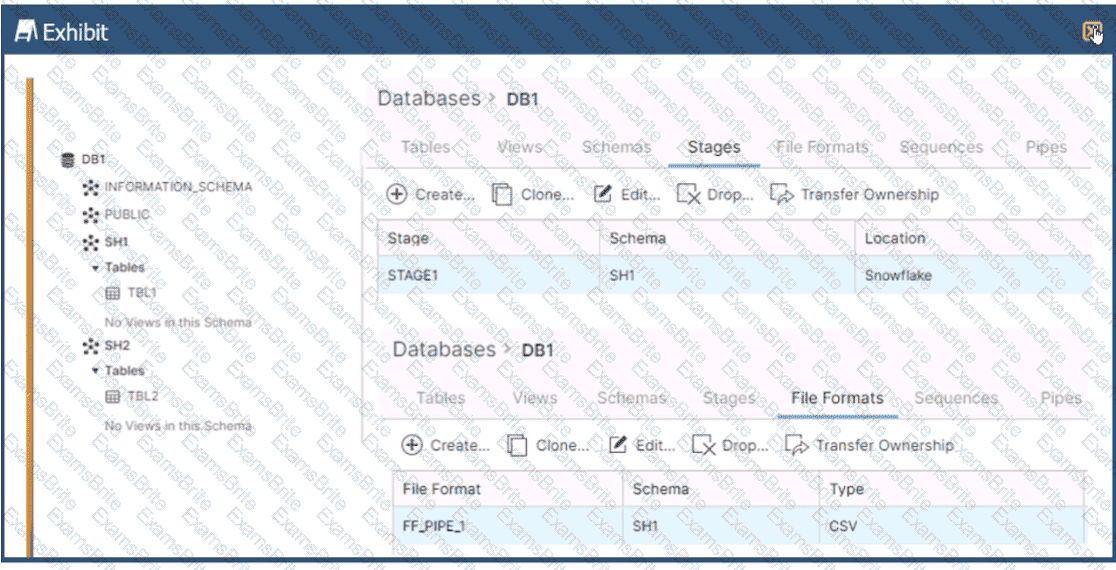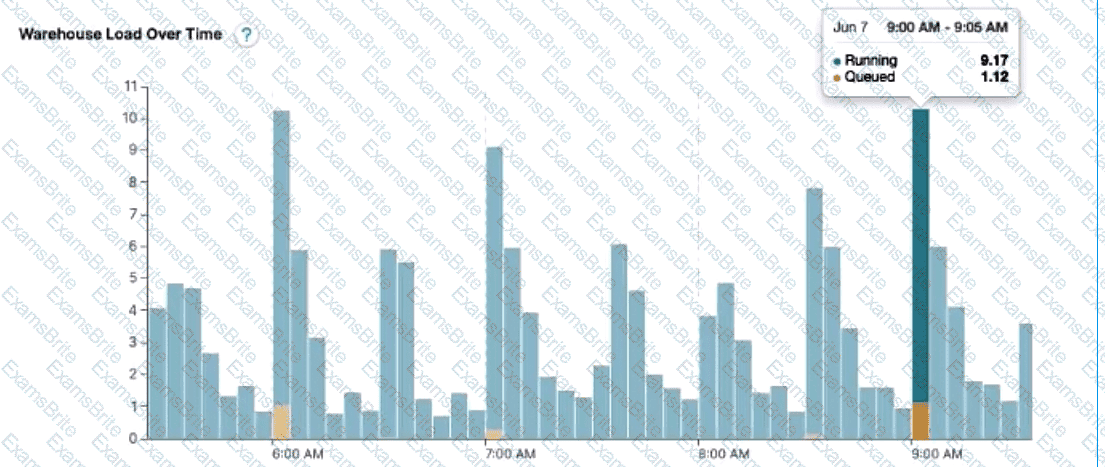
SnowPro Advanced: Architect Certification Exam
Last Update Dec 7, 2025
Total Questions : 162
We are offering FREE ARA-C01 Snowflake exam questions. All you do is to just go and sign up. Give your details, prepare ARA-C01 free exam questions and then go for complete pool of SnowPro Advanced: Architect Certification Exam test questions that will help you more.



Database DB1 has schema S1 which has one table, T1.
DB1 --> S1 --> T1
The retention period of EG1 is set to 10 days.
The retention period of s: is set to 20 days.
The retention period of t: Is set to 30 days.
The user runs the following command:
Drop Database DB1;
What will the Time Travel retention period be for T1?

Based on the architecture in the image, how can the data from DB1 be copied into TBL2? (Select TWO).
A)

B)

C)

D)

E)

An Architect is designing a solution that will be used to process changed records in an orders table. Newly-inserted orders must be loaded into the f_orders fact table, which will aggregate all the orders by multiple dimensions (time, region, channel, etc.). Existing orders can be updated by the sales department within 30 days after the order creation. In case of an order update, the solution must perform two actions:
1. Update the order in the f_0RDERS fact table.
2. Load the changed order data into the special table ORDER _REPAIRS.
This table is used by the Accounting department once a month. If the order has been changed, the Accounting team needs to know the latest details and perform the necessary actions based on the data in the order_repairs table.
What data processing logic design will be the MOST performant?
A media company needs a data pipeline that will ingest customer review data into a Snowflake table, and apply some transformations. The company also needs to use Amazon Comprehend to do sentiment analysis and make the de-identified final data set available publicly for advertising companies who use different cloud providers in different regions.
The data pipeline needs to run continuously and efficiently as new records arrive in the object storage leveraging event notifications. Also, the operational complexity, maintenance of the infrastructure, including platform upgrades and security, and the development effort should be minimal.
Which design will meet these requirements?
A data platform team creates two multi-cluster virtual warehouses with the AUTO_SUSPEND value set to NULL on one. and '0' on the other. What would be the execution behavior of these virtual warehouses?
A company needs to share its product catalog data with one of its partners. The product catalog data is stored in two database tables: product_category, and product_details. Both tables can be joined by the product_id column. Data access should be governed, and only the partner should have access to the records.
The partner is not a Snowflake customer. The partner uses Amazon S3 for cloud storage.
Which design will be the MOST cost-effective and secure, while using the required Snowflake features?
What Snowflake features should be leveraged when modeling using Data Vault?
The following chart represents the performance of a virtual warehouse over time:

A Data Engineer notices that the warehouse is queueing queries. The warehouse is sizeX-Small, theminimum and maximum cluster counts are set to 1, thescaling policy is set to standard, andauto-suspend is set to 10 minutes.
How can the performance be improved?
A global company needs to securely share its sales and Inventory data with a vendor using a Snowflake account.
The company has its Snowflake account In the AWS eu-west 2 Europe (London) region. The vendor's Snowflake account Is on the Azure platform in the West Europe region. How should the company's Architect configure the data share?
What is a characteristic of Role-Based Access Control (RBAC) as used in Snowflake?
A company is designing high availability and disaster recovery plans and needs to maximize redundancy and minimize recovery time objectives for their critical application processes. Cost is not a concern as long as the solution is the best available. The plan so far consists of the following steps:
1. Deployment of Snowflake accounts on two different cloud providers.
2. Selection of cloud provider regions that are geographically far apart.
3. The Snowflake deployment will replicate the databases and account data between both cloud provider accounts.
4. Implementation of Snowflake client redirect.
What is the MOST cost-effective way to provide the HIGHEST uptime and LEAST application disruption if there is a service event?
A healthcare company is deploying a Snowflake account that may include Personal Health Information (PHI). The company must ensure compliance with all relevant privacy standards.
Which best practice recommendations will meet data protection and compliance requirements? (Choose three.)
An Architect needs to improve the performance of reports that pull data from multiple Snowflake tables, join, and then aggregate the data. Users access the reports using several dashboards. There are performance issues on Monday mornings between 9:00am-11:00am when many users check the sales reports.
The size of the group has increased from 4 to 8 users. Waiting times to refresh the dashboards has increased significantly. Currently this workload is being served by a virtual warehouse with the following parameters:
AUTO-RESUME = TRUE AUTO_SUSPEND = 60 SIZE = Medium
What is the MOST cost-effective way to increase the availability of the reports?
What are characteristics of the use of transactions in Snowflake? (Select TWO).
Which query will identify the specific days and virtual warehouses that would benefit from a multi-cluster warehouse to improve the performance of a particular workload?
A)

B)

C)

D)

An Architect runs the following SQL query:

How can this query be interpreted?
An Architect has a VPN_ACCESS_LOGS table in the SECURITY_LOGS schema containing timestamps of the connection and disconnection, username of the user, and summary statistics.
What should the Architect do to enable the Snowflake search optimization service on this table?
A company’s daily Snowflake workload consists of a huge number of concurrent queries triggered between 9pm and 11pm. At the individual level, these queries are smaller statements that get completed within a short time period.
What configuration can the company’s Architect implement to enhance the performance of this workload? (Choose two.)
What Snowflake system functions are used to view and or monitor the clustering metadata for a table? (Select TWO).
A retail company has 2000+ stores spread across the country. Store Managers report that they are having trouble running key reports related to inventory management, sales targets, payroll, and staffing during business hours. The Managers report that performance is poor and time-outs occur frequently.
Currently all reports share the same Snowflake virtual warehouse.
How should this situation be addressed? (Select TWO).
An Architect would like to save quarter-end financial results for the previous six years.
Which Snowflake feature can the Architect use to accomplish this?
Which security, governance, and data protection features require, at a MINIMUM, the Business Critical edition of Snowflake? (Choose two.)
When using the COPY INTO
command with the CSV file format, how does the MATCH_BY_COLUMN_NAME parameter behave?
How can the Snowflake context functions be used to help determine whether a user is authorized to see data that has column-level security enforced? (Select TWO).
An Architect needs to design a Snowflake account and database strategy to store and analyze large amounts of structured and semi-structured data. There are many business units and departments within the company. The requirements are scalability, security, and cost efficiency.
What design should be used?
Which columns can be included in an external table schema? (Select THREE).
A company is storing large numbers of small JSON files (ranging from 1-4 bytes) that are received from IoT devices and sent to a cloud provider. In any given hour, 100,000 files are added to the cloud provider.
What is the MOST cost-effective way to bring this data into a Snowflake table?
A user is executing the following command sequentially within a timeframe of 10 minutes from start to finish:

What would be the output of this query?
Which steps are recommended best practices for prioritizing cluster keys in Snowflake? (Choose two.)
An Architect entered the following commands in sequence:

USER1 cannot find the table.
Which of the following commands does the Architect need to run for USER1 to find the tables using the Principle of Least Privilege? (Choose two.)
An Architect has designed a data pipeline that Is receiving small CSV files from multiple sources. All of the files are landing in one location. Specific files are filtered for loading into Snowflake tables using the copy command. The loading performance is poor.
What changes can be made to Improve the data loading performance?
A user named USER_01 needs access to create a materialized view on a schema EDW. STG_SCHEMA. How can this access be provided?
When using the copy into